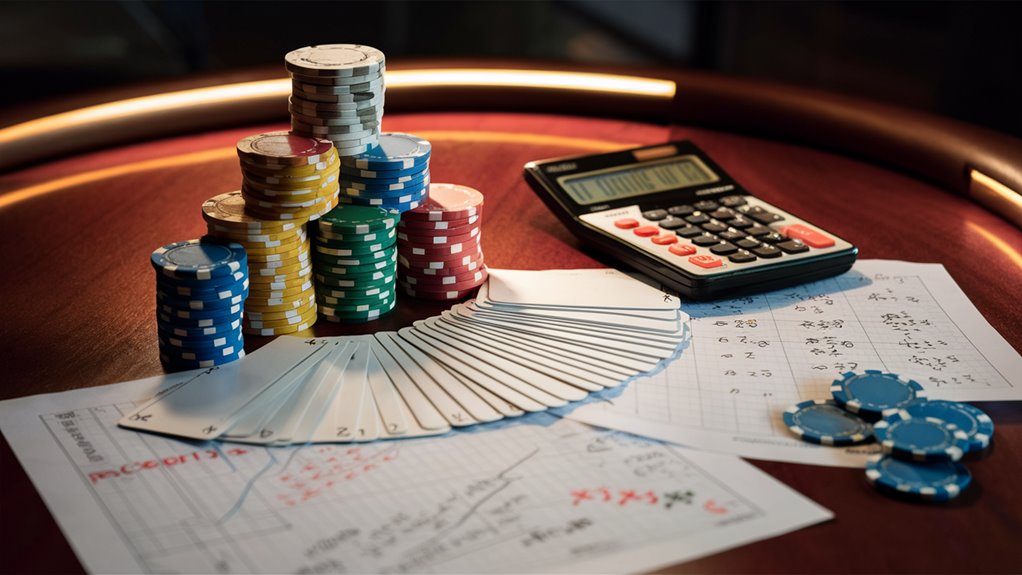Safe Betting: A Plan that Works with Data

Know the Math and How to Manage Risk
To win at betting, understand math and risk. Use the rules of chance and be careful with your money stash. A good risk rule is to bet only 2-5% of all you have. This way you can grow your stash while keeping safe from big losses.
Better Choices with Smart Plans
Know your spot and your foes to make money in games. This smart plan includes:
- Track changes as they happen
- Set limits to cut losses
- Use stats to guide bets
- Adjust bets based on risk
Keep Cool and Smart
To keep your head cool, take set breaks. Top players do:
- Handle stress well
- Make clear plans
- Track how they do
- Know how to bounce back
Get the Edge with Data
To spot good bet chances, you need:
- Analyze lots of data
- Spot patterns
- Great Casino Dealers
- Use market gaps
- Find your statistical edge
Stick to these rules in different settings for good profits, using strong tools and smart moves.
Know Your Chances and Value
Work Out Your Betting Odds
Start with Basic Math
The basics of chance are key. Know how to work out simple chances and value to make smart picks in games.
Using math, you can tell good bets from bad.
Find Out Your Value
The expected value shows what you might win or lose each time you bet, tested over many tries. For example:
- 40% chance to win $100: 0.4 × $100
- 60% chance to lose $50: 0.6 × -$50
- Total = $40 – $30 = $10
About the House Edge
The house edge is what the house might make from games. Like in roulette:
- Red/black bets have a 47% chance
- Payout stays the same
- Edge calc: (18/38 × $1) + (20/38 × -$1) = -$0.053
- It ends up as a 5.3% edge for the house
Choosing Smart
Pick smart games where skills help beat the house edge.
Games based on skills like poker let you get ahead with smart play and good money rules.
The Basics of Handling Your Money
Basic Rules for Managing Your Betting Money
About Allocating and Managing Risk
Good money rules need a math-based plan.
A main rule is each bet is 2-5% of all your money. This gives you 20-50 tries before you’re out. This method helps stay safe through the ups and downs.
Keep Money Apart and Right Sizing
Keep your bet money separate from what you need for living.
Smart players keep a stash at least 50 times their typical bet. Say, for $20 bets, save up a $1,000 betting fund.
Manage Time and Avoid Big Losses
Control your sessions with strict rules:
- Stop if down 25% of session money
- Aim to make 50% more than you start with
- Keep an eye on the reward-risk balance
Adjusting Your Bets
Watch your fund and change bets as needed.
If your money drops by 20%, bet less to keep risk steady.
Keep detailed records of your bets to track how you’re doing and tweak your approach.
Stay Level-Headed
Stay Calm to Win at Games
The Impact of Feelings
Winning at games often depends on staying calm at key times.
Studies show 70% of big losses happen when players get too upset or too pumped.
A good three-step plan – pause, think, adjust – lays the groundwork for smart choices.
Mandatory Cool Down and Why It’s Vital
The 10-minute cooling off time is key when things get rough. This break lets you think clearly, stopping rash decisions that often lead to more losses.
Keep a detailed record of how you do to spot trends and sharpen your game plan.
Do Well During Good Runs
Keeping balanced is really important when you’re winning. Studies show getting too sure can make you take 30% more high risks.
Using set risk rules helps you make good moves.
Thinking like a pro turns tough emotional times into chances to get ahead, boosting long-term results and steady wins.
What We Track
- Systems to check feelings
- Documenting plans
- Sticking to risk rules
- Checking patterns
- Watching how you adjust
Picking the Best Spot
Picking the Best Spot in Games

Fundamentals of Strategic Spot Selection
Picking a spot is a big skill that needs smart thinking over quick picks.
To master spot picking, know what affects your edge and how to stay away from skilled foes.
A Top Strategy for Poker Spot Picking
Being in a good spot is key in poker.
Watch betting for 15-20 hands before picking a spot. Place bold players on your right to keep an edge.
Things to watch include:
- How big stacks are
- How players bet
- The flow of the table
- See all that’s going on
About Spot Numbers and Results
Spots 7-9 in nine-hand games give you better info and control.
Your seat picks must be driven by strategy, backed by:
- Value calculations
- Checking player skills
- How deep the stacks are
- Evaluate the table flow
Keeping Your Spot on Point
Your spot needs regular checks every 30-45 minutes as the game changes. Keep an eye on:
- How betting changes
- Size changes in stacks
- How new players change things
- Shifts in the table vibe
Winning means always checking your spot’s strength against what’s happening now and what the others are doing.
Stay ready to change spots as the table changes through the game.
Using Data to Track How You Do
Use Data to Keep Track for Top Results
Systematic Data Gathering and Looking at Info
Systematic tracking of performance is key for making smart calls and managing your money well.
Keep detailed notes on every game session, including 온카스터디 how big your bets are, game choice, timing, and results. This shows key trends in how you do and your results.
Data-based study helps tweak your playing ways and risk rules.
Top Metrics and Checks
Using a strong tracking setup works out key numbers like return on investment (ROI), winning rates, and how things swing.
These numbers show the top chances for profit and spots where you might not do well.
Sorting performance by time, spot details, and who you play against gives insights to better your strategies.
Feelings and Situations Matter
To do your best, keep track of feelings and situations that change how well you make choices.
Watch how you feel and how tired you are when playing to spot the best times to play and when you might not do so well.
This help makes personal risk rules and sets how you play each session.
Handle Swings and Protect Your Cash
Smart ways to work out swings help set how much you need and keep you safe from market ups and downs.
Using real-time stops and setting how long to play, based on current data, lets you change your plan when things don’t go well.
This data-driven way keeps your performance and cash safe over time.
Getting to Know Other Players
Understand Your Poker Foes: A Strategic Plan
Get the Scoop on How Players Act
Watching and analyzing others is key to win at poker.
Players show useful info through their betting styles, timing, and how they move.
A planned way to keep track of these clues lets you make data-backed choices and profile opponents well.
Main Metrics for Seeing How Players Act
Three key numbers give good insight into how others play:
- How they bet vs. their stack
- How fast they decide
- How often they bet
These numbers help sort players from bold to cautious.
Small face changes, like around the eyes and mouth, can show hand strength well when you know what to look for.
A Full Plan for Reading Others
What to Watch and What It Means
- How they handle chips
- Changes in how they sit
- What they say
- How they hold themselves at the table
Smart Reading Moves
Reading foes right means looking at many clues, not just one thing.
Betting styles tell more than just moving body signs, as smart players often change how they act to trick you.
Focus on a planned way to keep and understand what others do over many hands.
The best plan looks at both betting styles and physical clues while knowing that skilled players might try to hide their real plays.
Seeing Risk the Right Way
A Full Guide to Seeing and Handling Risk
Get the Basics of Problems and Chances
Seeing and handling risk leans on three key chance parts: pot odds, what might come next, and value guesses.
Smart risk plans start with understanding the math tie between what you might lay down and what you could get back.
Work out pot odds by comparing the whole pot to what you must bet, setting a clear frame for choices.
Deep Dive into Chances
Looking ahead in odds means thinking past now to guess future rounds and what you might win. This deep look decides if hands worth drawing are worth more bets.
The guess work involves multiplying the chance of a hand by what you might win totally, then minus what it costs to see more cards.
Make the Most of Value Guesses
Value guesses (EV) guide smart choices in seeing risk. This math mixes multiplying outcomes by adding results, giving numbers you can act on.
Good EV guesses show chances to move ahead, while bad ones hint at pulling back.
The aim is long-term wins through steady use of chance-based looks more than just one-off results.
Core Parts of Seeing Risk:
- Math-based chance looks
- Smart choice frames
- Aiming for long-term wins
- Steady checking plans


